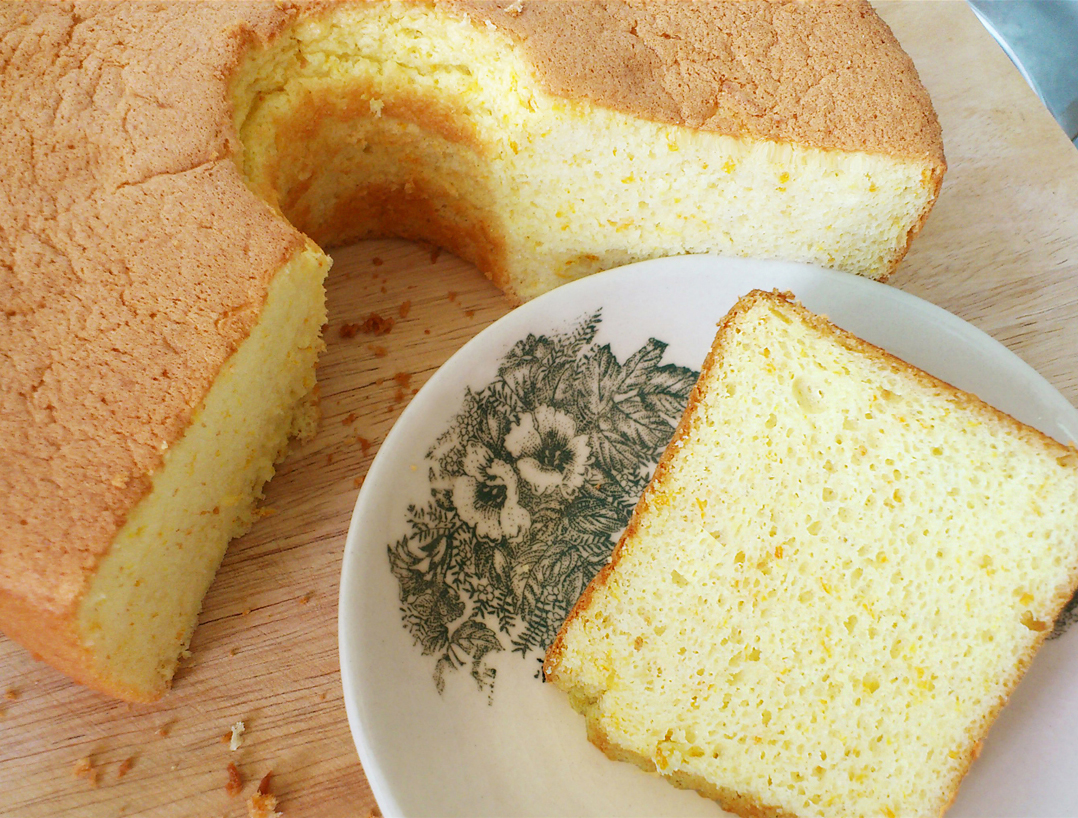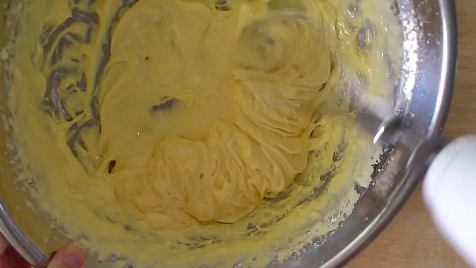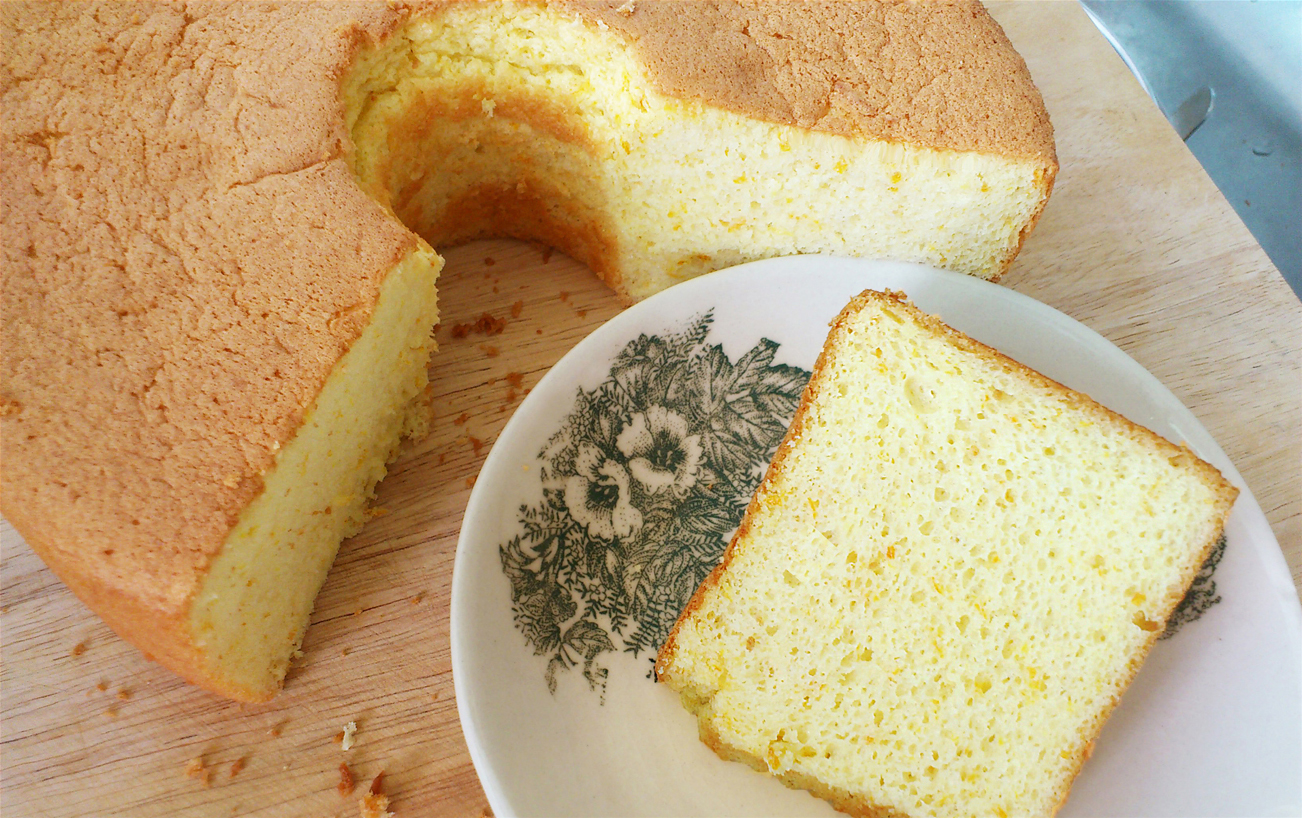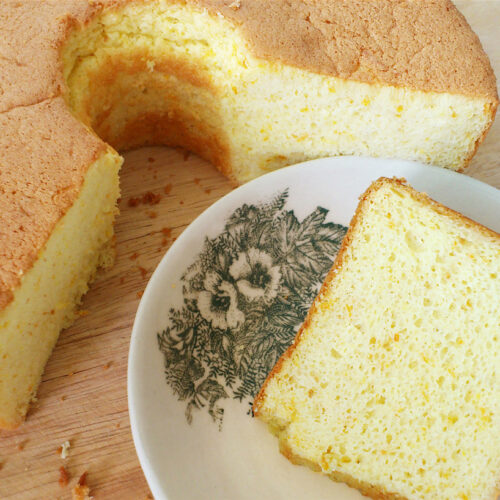Orange Chiffon Cake

To make a very orangey orange cake, you need lots of finely grated zest from the topmost, most oily part of the peel. Make sure you use a sharp grater or you’ll have more of the precious orange oil on your grater than in your cake.
Before you start grating, please get rid of the nasty stuff that’s sprayed on oranges. I wash mine in boiling water, then give them a good scrub and a thorough rinse under the tap.
Besides orange zest, you also need some orange juice.
If you use fresh OJ you squeeze out of oranges, you won’t taste it when the cake is freshly baked. It needs to rest overnight or at least eight hours for the flavour to develop.
If you use “fresh” OJ you pour out of a carton or bottle, the orange flavour is artificial even if the juice is “100% pure and natural” and “not from concentrate”. This is what I use for baking.
Man-made flavour is heat-stable, so it tastes the same before and after it’s baked. And it tastes like fresh OJ, which is why a lot of people don’t know their store-bought fresh OJ isn’t fresh at all. You’re not one of these suckers, are you?
My orange chiffon cake recipe is adapted from the pandan chiffon cake recipe I use. Because OCC is made with orange juice whereas PCC uses coconut milk, I’ve made four changes to the original recipe:
1) Cream of tartar, an acid used to stabilize the whisked egg whites, is reduced from ½ tsp to ⅓ tsp. Because orange juice is more acidic than coconut milk, the batter would be too sour if I use the same amount of cream of tartar as in the original recipe. The cake doesn’t rise well when it’s too sour because the more acidic it is, the quicker it sets.
2) Baking powder is reduced from 1 tsp to ¾ tsp. This is necessary because the orange flavour is mild compared to coconut milk. It doesn’t hide the baking powder’s bitter taste as well, hence the lesser amount.
3) To make PCC, corn oil is mixed evenly with egg yolks that have been whisked till thick and pale. For OCC, the corn oil is whisked with the thickened yolks till the mixture is thick once again, like mayonnaise. This helps prevent the OCC from drying out quickly in the oven. Why doesn’t PCC need the same procedure? Because it has coconut milk which doesn’t evaporate as easily as OJ when heated.
4) OJ replaces only the non-fat part of coconut milk. To make up for the lack of coconut fat, there’s more corn oil in OCC than PCC.
I like orange chiffon cake because it uses orange peel which I would have thrown away otherwise. And also because it uses corn oil which is cheaper than butter. And because it tastes of orange, which is nice. And because I like cakes that are soft and fluffy. Actually, I like dense cakes too. And also cupcakes, cheesecakes, ice-cream cakes, mooncakes, pancakes, crab cakes, fish cakes, two-way cakes . . . . Hey, there’s cake on my face!
No, I’m not fat (yet), in case you’re wondering.

Orange Chiffon Cake
Video
Ingredients
- 60 g egg yolks
- 50 g castor sugar
- 80 g corn oil
- 65 g orange juice
- 100 g cake flour
- ¾ tsp baking powder
- ¼ tsp salt
- 15 g finely grated orange zest
- 180 g egg whites
- ⅓ tsp cream of tartar
- 50 g castor sugar
Instructions
- Measure and prep ingredients as detailed above. Preheat oven to 200°C.
- Whisk egg yolks and 50 g castor sugar till thick and pale. Add corn oil. Whisk till thick again, like mayonnaise. Add orange juice. Whisk till evenly mixed. Sift sifted cake flour and baking powder into bowl. Add salt and orange zest. Mix till just even. Set aside. Thoroughly wash whisk.60 g egg yolks, 50 g castor sugar, 80 g corn oil, 65 g orange juice, 100 g cake flour, ¾ tsp baking powder, ¼ tsp salt, 15 g finely grated orange zest
- Whisk egg whites till very frothy. Add cream of tartar. Keep whisking till egg whites are thick. Gradually add 50 g castor sugar whilst continuing to whisk. Keep whisking till egg whites reach firm peak stage. Add to yolk mixture in 3 batches. Mix with whisk till almost even after each addition. Scrape down thoroughly with spatula. Fold till just evenly mixed. Bang bowl against worktop 2-3 times to remove big air bubbles in batter.180 g egg whites, ⅓ tsp cream of tartar, 50 g castor sugar
- Pour batter into 21 cm loose-bottomed chiffon pan that’s not non-stick, slowly so that big air bubbles burst as they flow out of bowl. Level batter with spatula. Run chopstick around sides of pan and knock pan 2-3 times against worktop to get rid of more big air bubbles.
- Place cake in bottom of oven. Reduce temperature to 180°C. Bake till cake is level with pan and slightly golden brown, about 20 minutes. Place baking tray in top of oven to block heat from top of oven. Continue baking till cake is brown and slightly springy when pressed, another 20-25 minutes, rotating as necessary so that cake browns evenly.
- Remove cake from oven. Invert and rest cake elevated from worktop. Leave till cool.
- Unmould by cutting cake out of pan.
- Slice and serve.